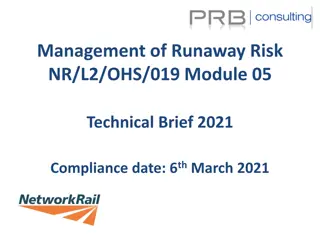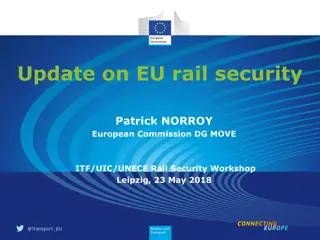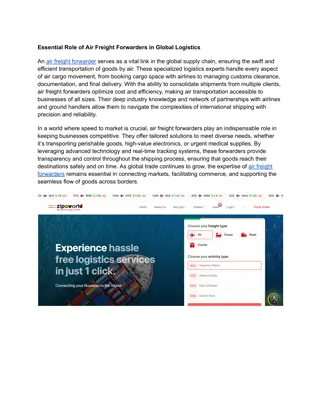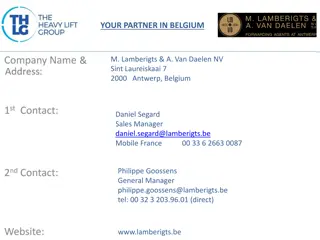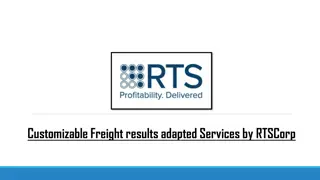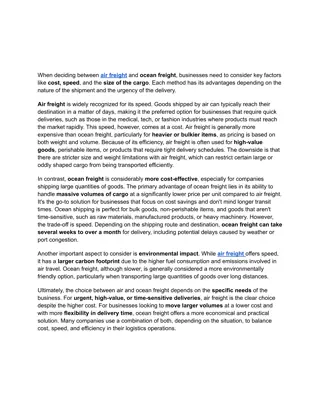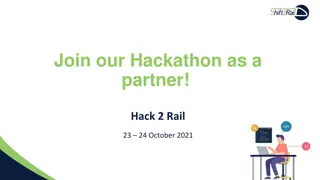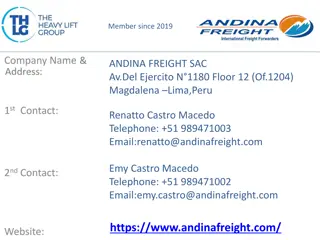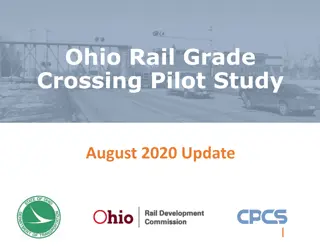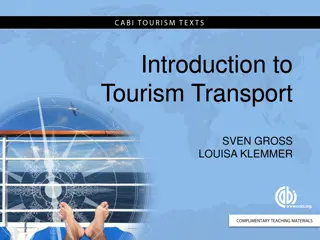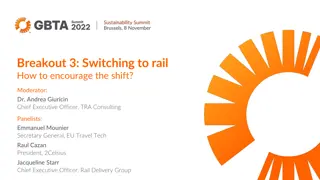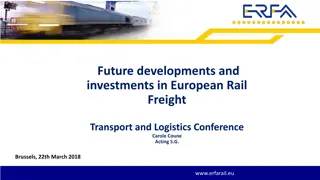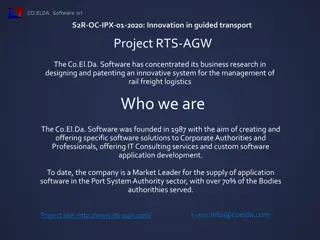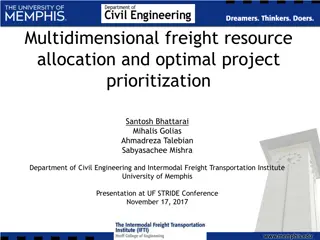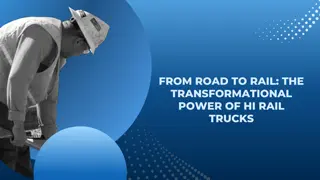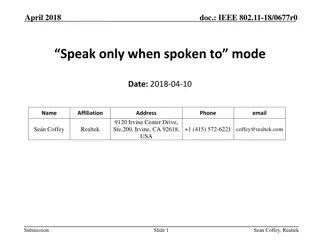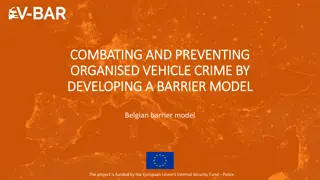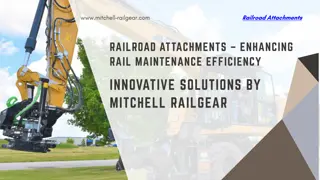Interdisciplinary Research on Rail Freight Mode Increase in Belgium
This project delves into strategies to enhance the rail freight mode's share in Belgium's intermodal chain by 2030. It explores competition levels in the Belgian rail freight market and identifies ways to maintain high competition. The extensive research assesses current market scope, active operators, and methodologies to analyze competition dynamics.
Download Presentation

Please find below an Image/Link to download the presentation.
The content on the website is provided AS IS for your information and personal use only. It may not be sold, licensed, or shared on other websites without obtaining consent from the author.If you encounter any issues during the download, it is possible that the publisher has removed the file from their server.
You are allowed to download the files provided on this website for personal or commercial use, subject to the condition that they are used lawfully. All files are the property of their respective owners.
The content on the website is provided AS IS for your information and personal use only. It may not be sold, licensed, or shared on other websites without obtaining consent from the author.
E N D
Presentation Transcript
BRAIN-TRAINS BELGIAN RESEARCH ACTION THROUGH INTERDISCIPLINARY NETWORKS TRANSVERSAL ASSESSMENT OF INTERMODAL NEW STRATEGIES Regulatory analysis FLORENT LAROCHE, CHRISTA SYS and THIERRY VANELSLANDER BELSPO project 3rd Workshop 18/09/2017 Ghent 1
CONTENT 1 Question 1 2 2 Perimeter 3 3 Methodology 4 4 Data collection 5 5 Results 6 6 Discussion 7 7 Conclusion 2/ 2/4 2 15 2
QUESTION BrainTrains project: How to increase the share of the rail freight mode in the intermodal chain by 2030 in Belgium? 1 S-1 Worst case S-2 Medium case S-3 Best case 2 4 operators 10 operators 2 operators 3 8M tons-km (+10%) 12M tons-km (+64%) 17M tons-km (+133%) 4 Question: How to ensure competition on the Belgian rail freight market? 5 Which level of competition on the current Belgian market? 6 Which levers for Belgian authorities to keep a high level of competition? 7 3/ 2/4 3 15 3
PERIMETER Market scope: Western European market Main figures for the Belgian market 1 2 7 billion Tons-km NO 3 > 70% of the traffic is international SE DK UK Connected to 3 major European corridors NL 4 (PL) DE BE LU (CZ) FR AT CH (HU) 5 12 active operators IT PT ES 6 Only 3 operators have their head office in Belgium 7 100% of operators are international (> one country) B logistics keeps 80% of market share (2013) 4/ 2/4 4 15 4
METHODOLOGY Two approaches to assess current competition 1 Dynamic approach (evolution) Static approach (picture) 2 Persistence of a firm s standardized profit rate (POP) = firm s profit rate average profit rate across all firms = , , n 3 = i = 4 CR is Concentration Ratio (CR4) 1 n = s 2 10 000 , HHI is Herfindahl-Hirschman Index (HHI) 4 t i t i t = 1 i / 1 = NE HHI Number equivalent (NE) Existence of abnormal profit in short-run (SR) and long-run (LR)? 5 Persistence on LR: low competition & high barriers 6 No Persistence on LR: high competition & low barriers 7 5/ 2/4 5 15 5
DATA COLLECTION Objective: identify each independent active operator on the market scope 1 Limits of usual databases: Eurostat: aggregated data UIC: no data for newcomers 2 3 Need for an extensive database Database Sources 4 Qualitative data (nationality, products, etc.) Website (operator) Amadeus database Annual report (operator) Annual report (operator) Website (operator) Amadeus database Amadeus database Amadeus database Turnover 5 Tons-km 6 Capital expenditures Labor expenditures EBITDA 7 169 active operators 6/ Limits: few time series 2/4 6 15 6
RESULTS STATIC APPROACH Creation and persistence of active operators on the Western-European market from 1850 - 2016 Western EU market 169 independent operators 1 80 70 2 49% are German (location of head office) 60 50 46% started to operate after 2000 3 40 26% operate at an international level (> one country) 30 4 70% are not specialized (> one market segment) 20 10 5 0 6 Estimated aggregated turnover 15 billion (2014) Source: own composition 7 7/ 2/4 7 5/9 2/4 7 15 7 7
RESULTS STATIC APPROACH Rank Company DB Schenker Rail Turnover ( ) Nationality Creation 1 4.517.000.000 DE 1994 Tight Oligopoly Loose oligopoly No oligopoly > 60% 25 60% < 25% 1 Rail Cargo 2 2.073.100.000 AU 1923 56% of the market SNCF Geodis 3 1.107.000.000 FR 1937 PKP cargo 4 999.767.000 PL 1918 2 SBB Cargo 5 821.240.009 CH 1902 Geneese&Wyoming 6 635.928.658 USA 1995 Trenitalia cargo 7 623.000.000 IT 1905 3 B logistics 8 451.860.473 BE 1926 Green cargo 9 444.266.000 SE 1856 4 Hupac 10 392.400.000 CH 1967 Europorte 11 267.000.000 FR 2005 RENFE mercancias 12 259.800.000 ES 1941 5 CTL Logistics GmbH 13 177.634.046 PL 2003 Low concentration Moderate concentration 1000 1800 High concentration Monopoly < 1000 CFL Cargo 14 153.793.792 LU 1946 HHI = 1266 6 Cargo Net 15 147.255.689 NO 1883 > 1800 10 000 Lotos Kolej 16 141.359.734 PL 2002 BLS Cargo 17 138.978.758 CH 1941 7 Verkehrsbetriebe Peine - Salzgitter 18 115.651.000 DE 1971 LKAB Malmtrafik 19 112.571.000 SE 1903 8/ Holding Exploris 20 94.000.000 LU 2014 2/4 8 15 8
RESULTS DYNAMIC APPROACH In short-run 1 Average short-run profit persistence (0,177) lower than in other industries (0,4-0,5) High competition 2 Dynamic competition (entry on the market) Quick erosion of the short-run persistence 3 In long-run 4 Remain barriers to entry (no convergence between firms) Standardised profit rates of all firms 0 (-0,011) 5 Risk of concentration (exit, mergers, alliances) 54% of firms have a negative long-run persistence of profit 6 7 9/ 2/4 9 15 9
DISCUSSION: HOW TO REGULATE ? Link between number of active operators and market size (ton-kms) in 2014 How to reach the best scenario? 1 Nb of operators S3 2 3 S2 ? 4 S1 5 Tons-Km Source: Authors 6 Source: Authors Transport policy (strategic targets) Contract of performance (operational targets) Network statement (pricing) Regulatory body (skills) 7 Benchmark according to 10/ 10 2/4 10 15
DISCUSSION: THE NETHERLANDS LEVER MAIN FACTS 1 Rail freight modal share: 3% (2000) 5% (2013) Rail freight traffic (ton-kms): 4,5 billion 6.1 billion (2013) General facts Every 10 years, current contract: 2015-2025 with yearly monitoring and deep evaluation of indicators and objectives at mid-term (2019). 11 indicators with quantitative objectives and penalties, including 2 for freight (user satisfaction and punctuality). National strategy for rail freight (2014) Main objectives: reduce CO2emissions and operating costs to increase market attractiveness. Rail policy supported by a financial fund of 2.4 billion (migration towards ERTMS, STS program to improve the daily resilience, the high-frequency program to increase the traffic, a third track towards Germany from the Betuwe route in 2022). Two types of modulation for rail freight: Price for access charges more attractive on the Betuwe route than the classic network (-24%); Advantage for access charges above 600 tons. Not specialized in rail No restrictive control on the network statement 2 Performance contract 3 Transport policy 4 5 Network statement 6 Regulatory body 7 The Netherlands Freight strategy for Rotterdam 11/ 11 2/4 11 15
DISCUSSION: AUSTRIA LEVER MAIN FACTS 1 Rail freight modal share: 27% (2000) 36% (2013) Rail freight traffic (ton-kms): 16,6 billion 19,3 billion (2013) Every 5 years, current contract: 2016-2021 with yearly monitoring. Indicators to control the implementation of the transport policy (progress of works, congestion, punctuality). Incentive scheme: financial penalties in case of non-achievement. National transport strategy (freight and passengers) between 2012 and 2025 Objectives for freight: + 42% in ton-kms for freight by 2025 and + 30% of capacity on the network. Actions: Yearly investment of 2 billion, reduction of bottlenecks, infrastructure modernization (ERTMS). Other: policy of subsidies for the rail freight market (single wagon, non-accompanied vehicle and rolling roads, ERTMS). Special penalties for freight upper 60 minutes of delay. Special discount for locomotives equipped with ERTMS on the equipped lines. Observatory of competition: - Analysis of the economic conditions. - Analysis of traffic and market share of new operators (per company). - Analysis of partnerships and mergers between national companies and foreigners. - Annual survey to know the market about network access, business factors, transport policy, technical standards, ) General facts Performance contract 2 3 Transport policy 4 Network statement 5 Regulatory body 6 7 Policy for competition on the market (strong monitoring) Austria 12/ 12 2/4 12 15
DISCUSSION: SWITZERLAND LEVER MAIN FACTS 1 Rail freight modal share: 52% (2000) 47% (2013) Rail freight traffic (ton-kms): 11.1 billion 11.8 billion (2013) General facts Every 3 years, current contract: 2017-2020 with yearly monitoring. Main indicators: Safety (number of collisions), availability of the infrastructure (number of slot cancelled), Productivity, etc. National program to develop the rail infrastructure by 2030 (PRODES): +70% of freight traffics Massive infrastructure investments since 1986 (Rail 2000) Taxes for road since 2001 (RPLP) according to the distance and the CO2emissions; Investment to reduce noise from rolling stock. Plan for migration towards ERTMS. Evaluation every three months of pricing for access charges according to the market and costs. Pricing modulation (incentives) for: - Locomotives with a good environmental performance. - Locomotives equipped with ERTMS. - Rolling stock equipped to reduce the noise. Independent Commission (CACF) to control the non-discrimination on the network mainly for pricing and access. Part of the Federal Office for Transport (OFT) which assumes the biggest part of the economic regulation Performance contract 2 3 Transport policy 4 5 Network statement 6 Regulatory body 7 13/ Switzerland Long term policy for rail & performance 13 2/4 13 15
DISCUSSION: BELGIUM 1 LEVER MAIN FACTS Rail freight modal share: 11% 14% (2013) Rail freight traffic (ton-kms): 7,7 billion (2000) 6.5 billion (2013) Every 4 years, last period: 2008 2012 Objective for freight: +35% tons-km between 2006-2012 One indicator with incentive for passenger (max number of minutes for delay) No indicator with incentive for freight Port connectivity: Antwerp & Zeebruges Safety and interoperability: full migration towards ERTMS in 2025 Modernization of the network: reduction from 350 traffic centers in 2005 to 31 in 2017 No advantage to the rail freight for access charges No restrictive control on network statement Limited control on the rail freight market because of the large share of international traffic General facts 2 Performance contract 3 Transport policy 4 Network statement 5 Regulatory body 6 Doubts about organization (holding/unbundling) Unclear strategy & monitoring for rail 7 Belgium 14/ 14 2/4 14 15 14
CONCLUSION: POLICY PATHS FOR SCENARIO Reach the best target under low concentration in Belgium (scenario 3) Specific target & long term Incentive scheme for shift from road to rail (taxes) Indicators for implementation of the transport policy Indicators for IM performance Incentive schemes towards the market for performance (noise, environmental, ERTMS) Extension of skills to: - All of the mode of transportation - Monitoring of the transport policy - Monitoring of the contract of performance - Observatory of the market and competition monitoring Transport policy 1 Contract of performance 2 Network statement 3 Regulatory body 4 5 Reach the best target under high concentration in Belgium (scenario 1) 6 Policy path similar to the previous one 7 Positive discrimination for access charges Creation of a specific European agency for regulation 15/ 15 2/4 15 15
Thank you for your attention. BRAIN-TRAINS BELSPO project 16
ANNEX DB Schenker Europorte 2006 Belo w Above Above the norm Below Below 2014 Below 2009 Incumbent: negative short-run since 2007 as sign of dominant position (Sys, 2010) New operator (2005): negative short- run & acquisition strategy (GB Railfreight, 2010)




